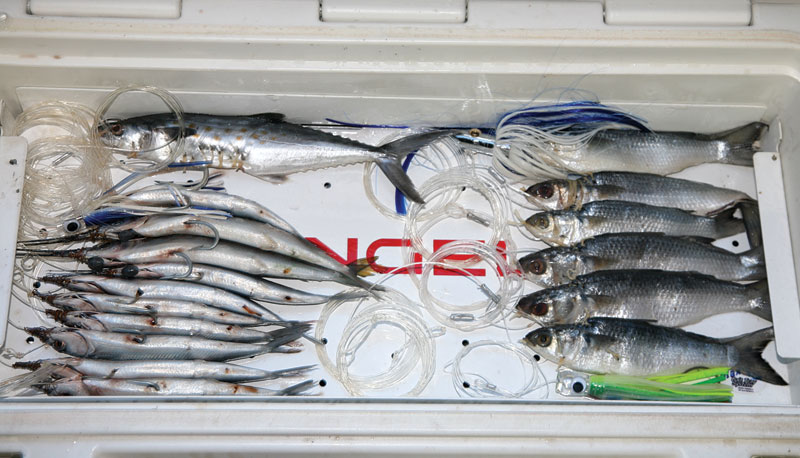
The skyrocketing price of fuel is a huge frustration for offshore anglers, right up there with strong winds that keep us on the dock as fish pass by in droves.
If there’s a silver lining to the dark cloud of high fuel prices, it’s that they won’t restrict anyone’s ability to catch fish. In fact, slowing down on the troll often produces more and bigger fish. A lot of my trolling is at speeds between 8 and 10 mph, and often I’ll drop to between 6 and 8 mph, depending on conditions.
It’s effective. Consider wahoo, notoriously receptive to fast trolling speeds, sometimes upwards of 15 mph. My three personal-best wahoo catches: In the Bahamas I scored a 143.3-pounder and a 113.2-pounder while trolling between 8 and 10 mph, whereas my biggest stateside wahoo — 66.75 pounds — hit a ballyhoo-tipped Ilander floundering behind the boat at around 3 mph as we slowed to gaff a 15-pound dolphin. Slower works. Trust me!
Here are some proven tactics to conserve fuel and raise fish at trolling speeds less than 10 mph.

Reconnaissance
The biggest fuel savings come when you know bait and fish whereabouts prior to setting forth. A line of communication with other anglers on fish whereabouts provides fuel-saving info, but satellite imagery revealing surface temperature breaks and circulation features is also a must. In South Florida I consult satellite analysis to find where the western edge of the Gulf Stream intersects deep structure between 1,200 and 1,500 feet. This eliminates a lot of searching and unnecessary fuel consumption.
Given the savings I see off South Florida, where the run to deep water is short, you can imagine how much fuel and money is saved by mid-Atlantic and Northeast canyon-bound anglers or those making long runs to structures and rigs in the Gulf of Mexico.

Natural Baits
Ballyhoo, mullet, mackerel, squid and belly strips are more in sync with slower trolling speeds than lures built to run at 10 to 15 mph. In addition, lighter, smaller baits and those rigged to swim work best at slower speeds, often as slow as 5 mph.
For example, a skipping ballyhoo dials in between 8 and 12 mph on average. Rig that same ballyhoo to swim, with a split beak and an egg sinker under its chin, and it comes alive just under the surface between 5 and 8 mph. These swimming baits have always been among the best producers in my spreads.
Another trick is to position skipping baits closer to the boat, where they’re influenced by the angle of their lines coming off a rod or outrigger clip. This sharper angle produces a more lifelike action at slower speeds than when the baits are positioned farther back.

Hey, Flat-head!
Certain lure styles lend themselves to slower trolling. Think lightweight with flat or concave faces. Trolling for dolphin, I often pull a couple of small lures, like the Williamson Sailfish Catcher and Dorado Catcher. The heads on these 6-inch lures churn and smoke in the 5-to 8 mph range. In addition, I’ll rig them with a 50- or 80-pound leader and a long-shank 8/0 hook to keep them light.
For variety, pair these lures with natural baits. A flat lure head creates disturbance, giving a natural bait more action at slower speeds. Natural baits lend scent and taste too, which become important at slower speeds.
One Big Tease
Slower trolling speeds reduce the amount of ground covered, so compensate by fishing in the right place and making fish come to you. Create a fish-attracting illusion by trolling daisy chains and even spreader bars as teasers. Both perform well at slower speeds. Enhance the illusion by adding dredges.
I commonly troll a hookless-squid spreader bar and a mullet daisy chain as surface teasers. Directly off each corner of the transom, I drag a large 104-fish Stripteaser dredge. Between the illusion of two large bait schools swimming eight to 10 feet deep and the spreader bar and daisy chain splashing away at the surface — not to mention my close baits — my wake looks alive. Game fish can’t help but swim in for a closer look. This is especially effective when fishing around a lot of boats. I present a different illusion than others around me.

Deep Rewards
Trolling slower also allows you to incorporate a downrigger, planer or wire-line outfit in the spread. Though wire line and some planers work equally as well at faster speeds, a downrigger performs best around 5 mph and loses its efficiency around 10 mph.
Visualize the teaser arrangement I described earlier, then consider how baits might be positioned deep and behind that commotion — especially on a sultry summer day. Not only does the teaser illusion extend from the surface to 10 feet down, but there’s a loaded bait in the mix.
Swimming plugs do well on deep lines or on their own. Consider large-lipped models like Rapala’s X-Rap Magnum and Mann’s Stretch series. These lures pull best at 5 to 8 mph, and even slower. I remember a trip off Venice, Louisiana, back in the ’80s, when Capt. Mike Frenette introduced me to trolling Rapala CountDown 18 lures for wahoo. Bobby Brack and I scored several large wahoo while trolling just four CD 18s no faster than 8 mph, with Brack nailing a 68-pounder.
Shut One Down
One tactic I employed even before gas got so expensive was shutting down one of my twin engines when going on the troll. Even today with state-of-the-art outboards, you can use 50 percent less fuel by shutting down one outboard.
Aboard twin-powered boats with multiple batteries and a charging link system, alternate outboards every hour. That way you’ll keep the hours the same on both engines. Aboard boats with just two batteries and no charging link system, limit trolling on each outboard to no more than 30 minutes to prevent battery drain from accessories when the outboard charging the respective battery is shut down.









